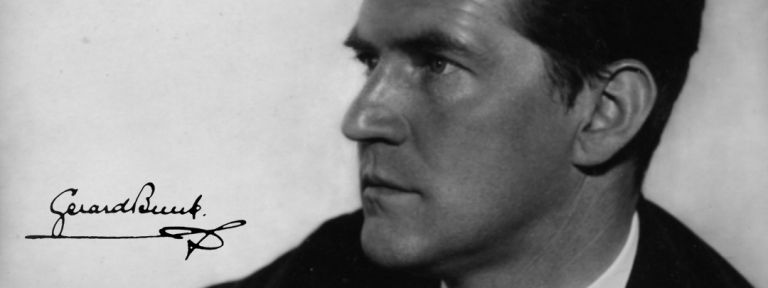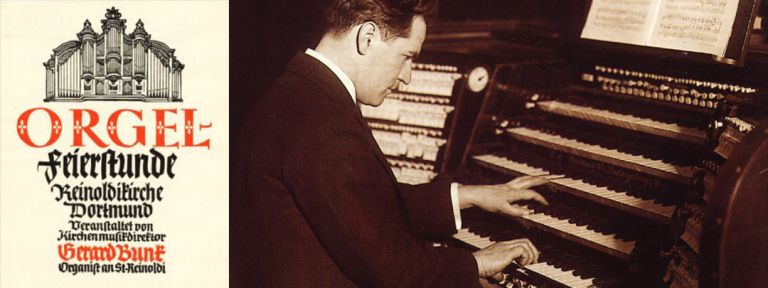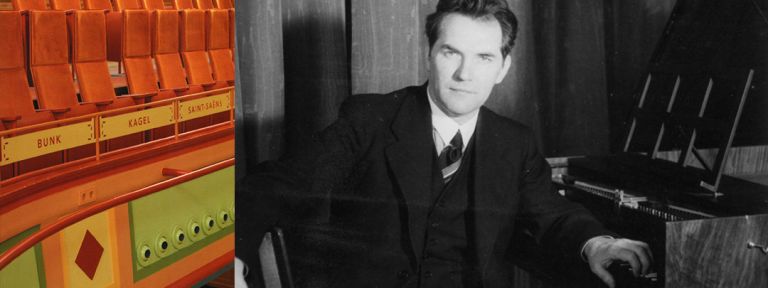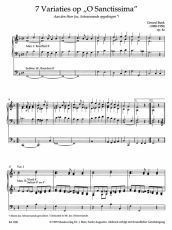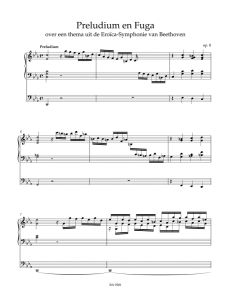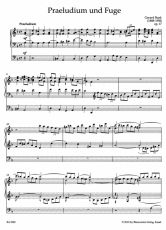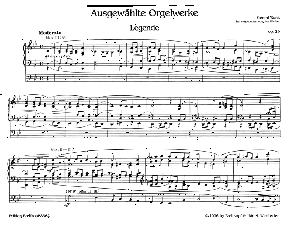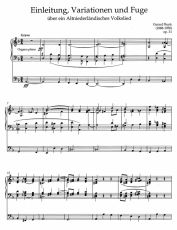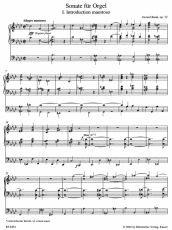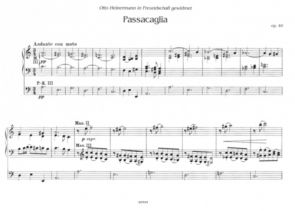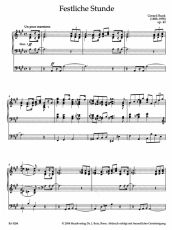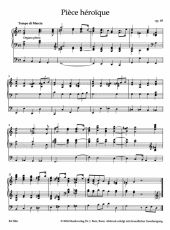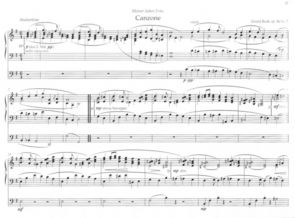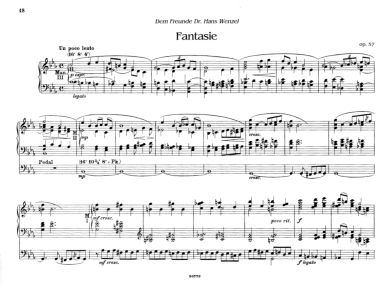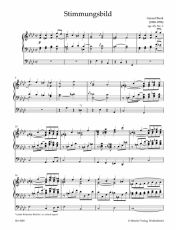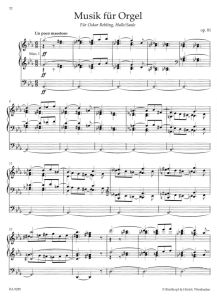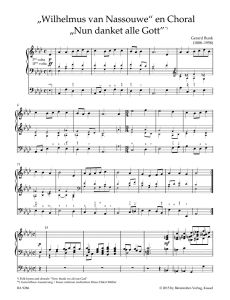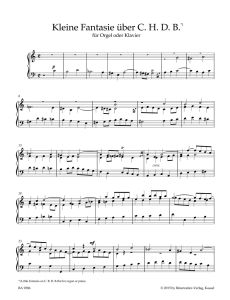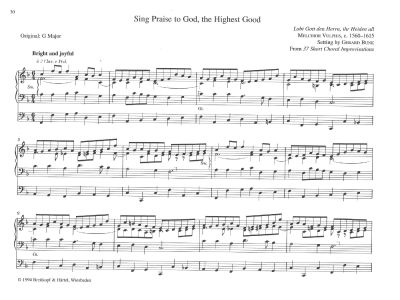Organ works
Works with opus number
Opus 4a
Seven Variations on "O du fröhliche"
composed: 1906
Editions:
- in O Sanctissima! Romantische Orgelbearbeitungen des Weihnachtsliedes »O du fröhliche«
Dr. J. Butz Musikverlag BU 1587 (1999)
Ed. Andreas Rockstroh
- in Complete Organ Works I, Bärenreiter Urtext BA 9281 (2008)
Eds. Jan Boecker / Wolfgang Stockmeier
Opus 8
Prelude and Fugue on a Theme from the Eroica Symphony by Beethoven
composed 1906
in Complete Organ Works I, Bärenreiter Urtext BA 9281 (2008)
Eds. Jan Boecker / Wolfgang Stockmeier
Opus 10
Sonatina in D minor
I. Allegro
II. Andante
III. Allegro-Praeludium
IV. Fuga
composed 1906/07
in Complete Organ Works I, Bärenreiter Urtext BA 9281 (2008)
Eds. Jan Boecker / Wolfgang Stockmeier
Opus 12
For Organ Pieces in Polyphonic Style
No. 1 Prelude in A minor
No. 2 Fugue in A minor
No. 3 Chorale Prelude "O Haupt voll Blut und Wunden"
No. 4 Fuga voor 2 clavieren en pedaal in A minor
composed 1906/07
Editions:
- in Complete Organ Works I, Bärenreiter Urtext BA 9281 (2008)
Eds. Jan Boecker / Wolfgang Stockmeier
- No. 3 in Romantic Organ Music from the Netherlands and Belgium, Breitkopf & Härtel EB 8621 (1997)
Ed. Wolf Kalipp
Opus 16
Five Organ Pieces
No. 1 Fugue in E minor
No. 2 Prelude in G minor
No. 3 Romance in G major
No. 4 Evening Song in C major
No. 5 Spring in G major
composed 1907
in Complete Organ Works I, Bärenreiter Urtext BA 9281 (2008)
Eds. Jan Boecker / Wolfgang Stockmeier
Opus 17
Prelude and Fugue in D minor
composed 1907
in Complete Organ Works II, Bärenreiter Urtext BA 9282 (2010)
Eds. Jan Boecker / Wolfgang Stockmeier
Opus 18
Five Organ Pieces
No. 1 Nocturne in D flat major
No. 2 Romance in C major
No. 3 Intermezzo in B minor
No. 4 Intermezzo in D minor
No. 5 Fugue (a 3 voci) D minor
composed 1907
in Complete Organ Works II, Bärenreiter Urtext BA 9282 (2010)
Eds. Jan Boecker / Wolfgang Stockmeier
Opus 28
Five Organ Pieces
No. 1 Improvisation in G flat major
No. 2 Album Leaf in F sharp minor
No. 3 Elegy in B minor
No. 4 Adagio in D flat major
No. 5 Prelude to "Wachet auf, ruft uns die Stimme" (lost)
composed 1907–12
in Complete Organ Works II, Bärenreiter Urtext BA 9282 (2010)
Eds. Jan Boecker / Wolfgang Stockmeier
Opus 29
Legend in G minor
composed 1908
Editions:
- in Selected Organ Works, Breitkopf & Härtel EB 8604 (1996)
Ed. Jan Boecker
- in Complete Organ Works II, Bärenreiter Urtext BA 9282 (2010)
Eds. Jan Boecker / Wolfgang Stockmeier
"presently Münsterthal
Dear Sir,
Thank you very much for sending the 'Legend.' I have not been able to play it, since I am resting my weary head in a fir forest far from any organs. But I did read it with great interest and took delight in it! Its style is an effective combination of that of Mendelssohn and that of César Franck, whose organ works I admire very much. I particularly like the serene and vivid layout of the whole. It is so refreshing in comparison to the formlessness and turmoil that is currently common in organ music.
Accept my thanks and kind regards. Unfortunately, you provided an incomplete address.
If you come to Strasbourg, I’ll show you my organs.
Your, Albert Schweitzer"
Schweitzer to Bunk, 19 May 1910
Opus 31
Introduction, Variations and Fugue on an Old Dutch Folk Song in D minor
composed 1908
Editions:
- Dr. J. Butz Musikverlag, BU 1623 (2000)
Ed. Jan Boecker
- in Complete Organ Works III, Bärenreiter Urtext BA 9283 (2009)
Eds. Jan Boecker / Wolfgang Stockmeier
"2 July 14 7, Rue des Saint-Pères
Highly Honored Colleague!
I have finally received and read your 'Variations and Fugue' with greatest interest.
=Scholarship, unity and profundity!=
A thousand congratulations
Believe me
Very cordially
Thankfully
Ch M Widor"
"... mi piacciono sopra-tutto le variazioni e la Fuga Finale. È un pezzo che entrera a far parte del repertorio di ogni buon organista." ("It is a piece that will one day be part of the repertoire of every good organist.")
Marco Enrico Bossi
"The piece, which was 'Variations and Fugue on an Old Dutch Folk Song', met with Schweitzer's full approval and complete appreciation. His verdict, which is very precious to me, confirmes nearly the same thing he wrote to me already many years ago about another organ opus by me ..."
(Bunk: Liebe zur Orgel, p. 101)
Opus 32
Sonata in F minor
I. Introduction maestoso: Allegro maestoso
II. Intermezzo grazioso: Andantino
III. Intermezzo cantabile (also for violin and organ)
IV. Finale mesto: Largamente – Andante funebre
composed 1909/10; revised in 1930
Editions:
- Bärenreiter BA 8454 (2002)
Ed. Jan Boecker
- in Complete Organ Works III, Bärenreiter Urtext BA 9283 (2009)
Eds. Jan Boecker / Wolfgang Stockmeier
"No, Gerard Bunk (1888–1958) really did not make it easy for his editor. No sooner had the F minor Sonata been composed and premiered in 1909 than he put it aside, only to thoroughly turn it upside down again 20 years later: the original middle movements were discarded and two Intermezzi were inserted instead, the second – 'Intermezzo cantabile' – also featuring an obbligato violin part ad libitum (enclosed with the score).
Is this the reason why the Sonata is only now, almost 44 years after Bunk's death, available as a first edition? Be that as it may, a closer acquaintance with the music of the Dutchman is in any case a gain. Even if Bunk has been placed in a row with Reger and Liszt, he has shaped quite an own and very appealing style. The great romantic organ before his eyes and ears thought Bunk in colorful sounds.
And so the Sonata also begins with strong chord progressions. But at no point does the movement become too dense, the whole remains beautifully audible and harmonically interesting. It is precisely the well-balanced play of contrasts, of timbres and movements, which is so inspiring in this Sonata. Thus the furious Allegro beginning and the striking 'Andante funebre' of the final movement are contrasted by the two cantabile Intermezzi.
Each in turn a character study in itself, for despite all the echoes of modernism, Bunk does not get caught up in the mannerisms of the zeitgeist. The whole is nicely balanced, quite virtuosic but not loud, and above all rich in surprising turns."
Markus Roschinski in Musik und Kirche, July/August 2002
"... Bunk is often considered in his relationship to Reger, and both artists respected each other highly. The Sonata in F minor, however, shows Bunk to be a distinctly independent composer.
... The overall character of the Sonata is reflected in the choice of keys and especially in the designation of the final ostinato 'Andante funebre'. Between the serious framework movements, the two Intermezzi each spread their own colour. The 'Intermezzo grazioso' breathes almost Lefébure-Wély-like cheerfulness and at the same time shows restrained dance-like verve. The 'Intermezzo cantabile' is more exotic with its ostinato accompaniment rhythms and a harmony which, as noted in the preface, is reminiscent of 'a Serenata under a Spanish sky'.
The movement is primarily chordal; the harmony is free of Wagnerian or Reger-like chromaticism, but offers interesting progressions beyond major-minor tonal cadential harmonies, especially in the intermezzi."
Joachim Schreiber in Orgel International 2002/5–6
Opus 40
Passacaglia in A minor
composed 1911; revised in 1929
Editions:
- in Selected Organ Works, Breitkopf & Härtel EB 8604 (1996)
Ed. Jan Boecker,
- in Complete Organ Works III, Bärenreiter Urtext BA 9283 (2009)
Eds. Jan Boecker / Wolfgang Stockmeier
"... You are a master of Variation ... ."
Wilhelm Middelschulte to Bunk, Chicago, 25 February 1935
"... Variations of rare diversity, beauty, and originality transform the theme in three intensifications that surpass each other. The work climaxes in a final movement in which yet a second motif, containing the four tones B A C H, joines the Passacaglia theme.
Out of the elements ostinato, fugue, and free fantasia emerges a finale that in terms of its free ant yet concentrated form numbers among the most perfect of the recent organ literature."
Dedicatee Otto Heinermann in Mitteilungen des Hauses Breitkopf & Härtel, March 1935
"Perhaps the Passacaglia, with its rich technique of variation, which at the end heads towards the B-A-C-H tone sequence, is the most perfect of all Bunk's large-scale works known to date."
Wolfgang Stockmeier in Musik und Kirche, September/October 1999
"Bunk was probably inspired to compose by his experience of the Reinoldi organ, which he had played for the first time in 1910, oddly enough alternating with Reger in the same concert. ...
Bunk makes use of all the technical possibilities of late Romantic alteration harmony and is no less daring than Reger, but his style is not so marked by sudden eruptions and is therefore clearer and more spacious.
There are pieces in which the B-A-C-H motif is latently present before it appears, as it were, expressis verbis. One senses: now it could come, and becomes almost uneasy about it. Suddenly, in the thirty-second variation, it sounds almost incidentally in the pedal, and it takes almost another hundred, no, one hundred and four bars until the B-A-C-H apotheosis finally takes place 'with all high-pressure voices'. An overwhelming development whose power to fascinate no one can escape!
The secret of the form of this Passacaglia lies in the fact that after 32 relatively firmly defined eight-bar variations, the eight-bar structure is abandoned without chaos entering. At the same time, the harmonic density increases. An exceptional work!"
Wolfgang Stockmeier in Musik und Kirche 81 (2011), issue 4, p. 98f.
Opus 43
Festive Hour in A major
composed 1912
Editions:
- in Gerard Bunk: Zwei festliche Orgelstücke, Dr. J. Butz Musikverlag BU 1849 (2004)
Ed. Hans Uwe Hielscher
- in Complete Organ Works IV, Bärenreiter Urtext BA 9284 (2011)
Eds. Jan Boecker / Wolfgang Stockmeier
Opus 49
Pièce héroïque in C major
composed 1914
Editions:
- in Gerard Bunk: Zwei festliche Orgelstücke, Dr. J. Butz Musikverlag, BU 1849 (2004)
Ed. Hans Uwe Hielscher
- in Complete Organ Works IV, Bärenreiter Urtext BA 9284 (2011)
Eds. Jan Boecker / Wolfgang Stockmeier
Opus 54
Eight Character Pieces
No. 1 Melody in A major (1911)
No. 2 Scherzando in F major (1919?)
No. 3 Impromptu in C major (1919?)
No. 4 Improvisation in B flat major (1911)
No. 5 Pastoral in A major (1910)
No. 6 Aeolian Harp in A minor (1916 or earlier)
No. 7 Canzona in G major (1919?)
No. 8 Allelujah in B flat major (1912 or earlier)
Editions:
- Möseler / Schott Music M 19.226 (2003)
Ed. Wolfgang Stockmeier
- in Complete Organ Works IV, Bärenreiter Urtext BA 9284 (2011)
Eds. Jan Boecker / Wolfgang Stockmeier
- No. 2 in Orgelscherzi der Belle Epoque, Robert-Forberg-Musikverlag (1995)
Ed. Kurt Lueders
- No. 5 in Christmas for Organ, Bärenreiter BA 8495 (2004)
Ed. Andreas Rockstroh
- Nos. 6–8 in Romantic Organ Music from the Netherlands and Belgium, Breitkopf & Härtel EB 8621 (1997)
Ed. Wolf Kalipp
Arrangement:
No. 1 in Organ Plus One. Original Works and Arrangements for Church Service and Concert. Low Instruments I, Bärenreiter BA 11214 (2013)
Arr./Ed. Carsten Klomp
"It is safe to say that they are among the most spirited character pieces after Rheinberger."
Wolfgang Stockmeier in the preface
"Bunk's Aeolian Harp, in which e2-a3-e3 is 'fixed' (pencils or lead weights or page-turners) at the beginning of the piece, belongs to those tone pictures that only late Romanticism was able to 'conjure'."
Jörg Strodthoff in Musik und Kirche, March/April 1998
Opus 57
Fantasia in C minor
composed 1915
Editions:
- in Selected Organ Works, Breitkopf & Härtel EB 8604 (1996)
Ed. Jan Boecker
- in Complete Organ Works IV, Bärenreiter Urtext BA 9284 (2011)
Eds. Jan Boecker / Wolfgang Stockmeier
"Bunk composed no more major organ works in the last forty years of his life; the Fantasia op. 57 from 1915 is already the penultimate in a series of six enormous works. The reason for this is probably to be found in the emerging 'Orgelbewegung', whose stylistic prudishness, often observed, was not favourable to symphonic organ music.
Today, we can hardly understand why works of such grand proportions as those by Bunk or Karg-Elert did not find a majority among organists and had to give way to products of rampant organ idiocy for a long time. The Fantasy op. 57 is therefore almost a legacy, an extended symphonic movement to which Bunk occasionally gave the subtitle 'through night to light!'"
Wolfgang Stockmeier in Musik und Kirche, September/October 1999
Opus 65
Six Organ Pieces
No. 1 Tone Picture in F minor (1919?)
No. 2 Idyll in G major (1917)
No. 3 Consolation in F minor (1923)
No. 4 Melody in B major (1926)
No. 5 Wedding Procession in G major (1928)
No. 6 Duo (Canon) in F sharp minor (1936)
Editions:
- Möseler / Schott Music M 19.227 (2006)
Ed. Wolfgang Stockmeier
- in Complete Organ Works V, Bärenreiter Urtext BA 9285 (2013)
Ed. Jan Boecker
Opus 81
Music for Organ in C minor
composed 1939
- in Complete Organ Works V, Bärenreiter Urtext BA 9285 (2013)
Ed. Jan Boecker
"Bunk's Music for Organ from 1939 has a very stubborn beginning. In the full work, chords are heard that are moved down a half tone one after the other. When they reach the bottom, the chords rise again in half tone steps. This happens twice, flanked by mighty sustained notes in the pedal. ... The piece is harmonically very densely composed. Movements in half tone steps are the rule. The tempo changes frequently and the triplet movement dominates until a song without words is heard − a simple chorale. This second, clearly delimited part again approaches a more diatonic, catchier tonal language − it is lighter and more pleasing. Then there is a reprise of the musical material from the beginning of the piece. Gradually the music calms down. Orchestrated differently, the simple song returns. Then the Music for Organ unfolds its greatness and breadth ..."
Walter Liedtke in the programme booklet Organrecital Willibald Guggenmos, 4 October 2018, Konzerthaus Dortmund
Own works and arrangements without opus number
"Wilhelmus van Nassouwe" and Chorale "Now Thank We All Our God"
on YouTube
composed 1907
in Complete Organ Works VI, Bärenreiter Urtext BA 9286 (2015)
Ed. Jan Boecker
"I had to play an organ concert on the occasion of the Queen's birthday in the delightful, still typically picturesque little Dutch town of Kampen, where there is a mighty old organ in the large church. As already mentioned, the programme began everywhere with the recital of the national anthem in honour of the Queen. I wanted to embellish this introduction by composing a longer piece for it, which began with the national anthem and then, leading into the chorale 'Nun danket alle Gott' ('Now Thank We All Our God'), concluded the whole thing very artfully with this in counterpoint."
Gerard Bunk: Liebe zur Orgel, p. 120f.
CADENZA TO THE ORGAN CONCERTO IN F MAJOR [NO. 4, OP. 4/4] BY G. F. HÄNDEL
composed 1926?
Manuscript
Little Fantasia on C. B. D. B-flat
for organ or piano
composed in the 1940s
in Complete Organ Works VI, Bärenreiter Urtext BA 9286 (2015)
Ed. Jan Boecker
J. S. Bach: "The Art of Fugue"
transcribed for the organ
for the Bach Year 1950
Manuscript
J. S. BACH: CANONS, FUGUES AND RICERCARI FROM THE "MUSICAL OFFERING"
Breitkopf & Härtel EB 6227 (1956)
"Lambarene − Gabon 18.4.60
Dear Mrs. Bunk
Thank you very much for sending me such a beautiful work by your husband. He has done this transcription for organ very beautifully. I marvelled at the way he solved the problems. He knew the organ thorougly. That is a gift he leaves to the organists. How nice that Breitkopf has published it. I hope you are well. My fate is that my work gets bigger and bigger with age. I no longer know how to manage it.
Thank you very much, once again
Your sincerely Albert Schweitzer"
Chorale Prelude "Wake, Awake, For Night Is Flying"
(Trio a 2 Clav. e Pedale)
composed in the 1950s
Editions:
- in 37 Choralimprovisationen und Choralvorspiel »Wachet auf, ruft uns die Stimme«, Dr. J. Butz Musikverlag BU 1559 (2002)
Eds. Hans Uwe Hielscher / Wolfgang Stockmeier,
- in Complete Organ Works VI, Bärenreiter Urtext BA 9286 (2015)
Ed. Jan Boecker
37 short Chorale Improvisations
for Use in the Church
No. 1 Lob Gott getrost mit Singen
No. 2 Es kommt ein Schiff, geladen
No. 3 Christ, unser Herr, zum Jordan kam
No. 4 Alles ist an Gottes Segen a 2 Clav. e Pedale
No. 5 Mein Herzensjesu, meine Lust
No. 6 Vom Himmel kam der Engel Schar (Vom Himmel hoch, da komm ich her; variant), Trio a 2 Clav. e Pedale
No. 7 Nun freut euch, lieben Christen gmein a 2 Clav. e Pedale
No. 8 Zeuch ein zu deinen Toren a 2 Clav. e Pedale
No. 9 Nun lob, mein Seel, den Herren a 2 Clav. e Pedale
No. 10 Jauchz, Erd und Himmel, juble hell a 2 Clav. e Pedale
No. 11 Wunderbarer König a 2 Clav. e Pedale
No. 12 Unser Herrscher, unser König pro Organo pleno
No. 13 Komm, o komm, du Geist des Lebens a 2 Clav. e Pedale
No. 14 Vom Himmel hoch, da komm ich her (Vom Himmel kam der Engel Schar; variant), Trio a 2 Clav. e Pedale
No. 15 Vater unser im Himmelreich (in Canone) a 2 Clav. e Pedale
No. 16 Lasset uns den Herren preisen (Sollt ich meinem Gott nicht singen) pro Organo pleno
No. 17 Dieweil wir sind versammelt (Ich weiß, woran ich glaube) a 2 Clav. e Pedale
No. 18 Jauchzt, alle Lande, Gott zu Ehren (Ich lobe dich von ganzer Seelen) pro Organo pleno
No. 19 Nun preiset alle Gottes Barmherzigkeit pro Organo pleno
No. 20 Wach auf, wach auf, du deutsches Land pro Organo pleno
No. 21 Mein Schöpfer, steh mir bei (Trio) a 2 Clav. e Pedale
No. 22 Lobet den Herrn, ihr Heiden all a 2 Clav. e Pedale
No. 23 Herzlich tut mich verlangen (Aria) a 2 Clav. e Pedale
No. 24 Gottes Sohn ist kommen a 2 Clav. e Pedale
No. 25 Herr Jesu Christ, meins Lebens Licht
No. 26 Kleine Orgelpartita über das Lied »Ist Gott für mich«
No. 27 Machs mit mir, Gott (Mir nach, spricht Christus, unser Held; Doppelkanon)
No. 28 Wir wollen alle fröhlich sein
No. 29 Jesu, meines Lebens Leben a 2 Clav. e Pedale
No. 30 Nun danket alle Gott pro Organo pleno (manualiter)
No. 31 O Durchbrecher aller Bande a 2 Clav. e Pedale
No. 32 Befiehl du deine Wege (Aria) a 2 Clav. e Pedale
No. 33 O Traurigkeit, o Herzeleid a 2 Clav. e Pedale
No. 34 Dir, dir, Jehova, will ich singen pro Organo pleno
No. 35 Da Christus geboren war (Treuer Wächter Israel) a 2 Clav. e Pedale (in Canone)
No. 36 Wer nur den lieben Gott läßt walten (Aria) a 2 Clav. e Pedale
No. 37 In dich hab ich gehoffet, Herr a 2 Clav. e Pedale (in Canone)
composed 1956–58
Complete Editions:
- 37 Choralimprovisationen und Choralvorspiel »Wachet auf, ruft uns die Stimme«, Dr. J. Butz Musikverlag BU 1559 (2002; transposed)
Eds.. Hans Uwe Hielscher / Wolfgang Stockmeier
- in Complete Organ Works VI, Bärenreiter Urtext BA 9286 (2015; in the original keys)
Ed. Jan Boecker
Single Editions:
Nos. 22, 25, 37 in in Ewigkeit dich loben 1–3, Breitkopf & Härtel EB 8571–73 (1993/94)
Ed. Klaus Uwe Ludwig
No. 22 in An Eternity of Praise: European Connection, Vol. 1, 30 chorale preludes from present-day Germany, Concordia Publishing House 976782 (1999)
Ed. John A. Behnke
Arrangement:
No. 26 in organ plus one. Original Works and Arrangements for Church Service and Concert. Reformation: Hymns by Martin Luther, Bärenreiter BA 8508 (2016)
Arr./Ed. Carsten Klomp
"'Originating from the practice, this collection is intended for the practice', Bunk writes in his own preface. In fact, the Chorale Improvisations were his last work and remained unfinished. Of 50 planned pieces, he was only able to complete 37 ... They also form an interesting borderline case of improvisation on the way to composition."
Hans-Jürgen Kaiser: Die Kunst der Improvisation, in: Ars Organi, June 1999
Six Masterpieces
transcribed for the organ
No. 1 William Byrd: The Bells
No. 2 Johann Sebastian Bach: Sinfonia of the Ratswahlkantate no. 29 »Wir danken dir, Gott«
No. 3 Johann Sebastian Bach: Adagio of the first sonata for violin solo senza basso (BWV 1001) as introduction to Bach's organ transcription (in D minor) of the following fugue of this sonata
No. 4 Johann Sebastian Bach: »Wohl mir, daß ich Jesum habe«, chorale from cantata no. 147
No. 5 Felix Mendelssohn Bartholdy: Prelude, Fugue and Chorale from "Six Preludes and Fugues for piano" (op. 35)
No. 6 Franz Schubert: Fugue in E minor for piano four hands (op. 152, D 952)
compiled 1957
Manuscript
